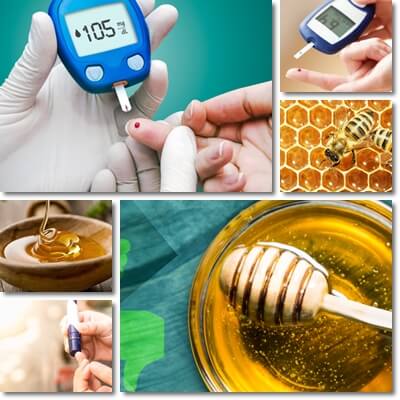Can diabetics eat honey? While diabetics can theoretically eat honey in very, very small amounts and only occasionally, it’s better if they don’t. There is a good reason why most doctors will recommend diabetics avoid honey altogether. Why? Because chemically speaking, honey is sugar. A natural source of sugar, but still sugar. And sugar in all forms, whether it’s table sugar, fruits or honey will cause spikes in blood sugar levels in both healthy people and diabetics. It’s also extremely difficult to measure honey so you know how much sugar the amount you’re eating contains. And this a very dangerous aspect for a diabetic person who must rigorously keep count of their total carbohydrate, sugar and calorie intake.
For a diabetic person, even one tablespoon of honey can cause a serious spike in blood sugar levels. The severity of the disease, the degree of insulin resistance, current weight, diet and habit of combining foods are all factors that play big parts in determining whether someone with diabetes can safely taste a teaspoon of honey once in a while or experience side effects and complications of their condition as a result. Just as they are better off avoiding table sugar, candy and other sweets, diabetics are better off avoiding honey as well.

Diabetes is a disease of the metabolism, meaning the body finds it difficult to process the nutrient we popularly call sugar into energy. And this calls for extra attention when eating sugar, whether it’s complex carbohydrates like those in fruits and vegetables or plain, simple sugars like the ones in honey. Every diabetic person has a daily limit to how much carbohydrates, sugars and calories (weight gain worsens the condition) they can eat. This is why it’s so important they avoid foods that rank high in sugar and carbohydrates and opt for foods that are as low as possible in both of them, but high in essential nutrients such as vitamins, minerals, protein, fat. And this means honey is a food that is best avoided in diabetes.
Honey sugar content
Honey is made up of mostly sugar. Most varieties contain anywhere from 13% to 17% water and very few around 20-24% water. This means that your average honey with a 17% water content is 82% carbohydrates (mostly simple sugars, glucose and fructose). In other words, a typical honey contains 82 g of sugar per 100 g, which is a lot and the main reason why many doctors don’t recommend the bee product to diabetics.
One tablespoon (estimated at 21 g) provides approximately 16-17 g of sugars.
One teaspoon (estimated at 7 g or 1/3 of a tablespoon) provides approximately 5.3 to 5.6 g of sugars.
One teaspoon (estimated at 5 g) provides about 4 g of sugars.
Honey sugar composition
As mentioned above, honey is basically sugar. It’s actually made up of 3 to 5 different types of sugar: glucose, fructose (main sugars) and smaller amounts of sucrose and sometimes maltose and galactose. Most honeys are higher in glucose than fructose, but there also varieties with similar amounts of glucose and fructose and, more rarely, slightly more fructose than glucose. Honey varieties higher in glucose crystallize soon after harvesting (examples: sunflower honey). Those with almost equal amounts of glucose and fructose or slightly higher in fructose crystallize very slowly, over the course of a few years (example: acacia honey).
Glucose and fructose are simple sugars and readily absorbed into the bloodstream. And without any complex carbohydrates (fiber), fats or protein, eating honey is just like eating plain sugar. This is also the reason why some doctors think honey is bad for diabetes.

Honey glycemic index (highly variable)
Raw honey glycemic index value: ranges from 50 to 55 and up to about 60, depending on the variety. The glycemic index (GI) measures how fast or slow a food raises blood sugar levels. Foods are compared with pure glucose which has a glycemic index of 100, meaning glucose causes the most rapid rise in blood sugar levels.
Foods with a glycemic index of 55 and lower are considered low GI.
Foods with a glycemic index of 55-69 are moderate GI.
Foods with a glycemic index over 70 are high GI.
Depending on the variety, honey may have a glycemic index of 50-55 and up to 60. The more fructose and less glucose a honey contains, the lower its glycemic index. This is because fructose has a low glycemic index (25) compared to glucose which has the highest glycemic index (100). The more glucose a honey has, the higher its glycemic index and the worse it is for diabetes. However, the low and moderately low glycemic index is not a good enough reason to eat honey if you’re diabetic.
Glycemic index value of honey and sugar: comparison. Table sugar (sucrose, made from glucose and fructose) has a GI of 65. This is fairly close to the GI of honey and some varieties in particular. But neither sugar, nor honey are good options for diabetics.
Reasons to avoid honey with diabetes
1) Honey is typically over 80% sugar. It’s just too much.
2) It has no fiber, no fat, no protein to slow down the absorption of sugar into the bloodstream.
3) It’s difficult to determine how much honey a diabetic person can eat safely and even the smallest amounts are significant sources of sugar.
Example: 1 teaspoon of only 5 grams has about 4 g of sugar. It’s a lot.
4) Honey is delicious and nobody stops at 1 teaspoon. Especially not one a day. And who can resist not eating a good honey except for once in a while, infrequently, occasionally?
5) Not all diabetics are the same. Some tolerate some foods better than others, while others experience side effects more easily than others and in response to smaller intakes of certain foods.
6) Long-term, honey can favor weight gain and worsen diabetes in some cases.
7) There is a risk of allergic reactions. If you have or suspect an allergy to bees, bee pollen or bee products (honey, royal jelly, propolis – see Honey Page), avoid eating honey, whether you’re diabetic or not.
How to make honey safe for diabetes
If you are diabetic and insist on having a taste of honey, and I stress taste, you must first ask your doctor if your condition allows you, individually, to do so. If your doctor feels it would be safe for you to eat very, very small amounts once in a while, then consider the following aspects:
1) Plan ahead for it. When and if a diabetic person eats honey, they must first calculate the number of calories and grams of carbohydrates in the very minimal amounts of honey they are allowed to eat so they don’t exceed their daily energetic value recommendations and maximum recommended intake of carbohydrates.
2) Remember you can only eat very, very small amounts at once and rarely, infrequently. Ask you doctor what would be a good amount to start with. The doctor might recommend a teaspoon (5 g) at most.
3) Never on an empty stomach. Never with a meal rich in carbohydrates. You may consider eating a teaspoon of honey if you have a lean protein meal first. The protein and small amounts of fat in it will temper and slow down the absorption of the sugars in the bloodstream and reduce the chances of blood sugar spikes.
4) Take into account the individual effects of honey and honey intakes. Some people with diabetes may get away with a teaspoon of honey every now and then, but you might feel sick even after as little as that.
Conclusion
While you can technically eat honey with diabetes, it’s best you don’t. Honey is still a sugar, albeit natural, and can easily lead to spikes in blood sugar levels and associated side effects. Even though it’s a natural product and otherwise healthy, honey is just not a good food option for diabetics. And most important, honey is not a healthier substitute for sugar if you have diabetes. Chemically speaking, it’s the same thing. Actually, table sugar or sucrose is made of glucose and fructose, the same glucose and fructose found in honey. Last but not least, always consult with your doctor about what you can and cannot eat with diabetes.
